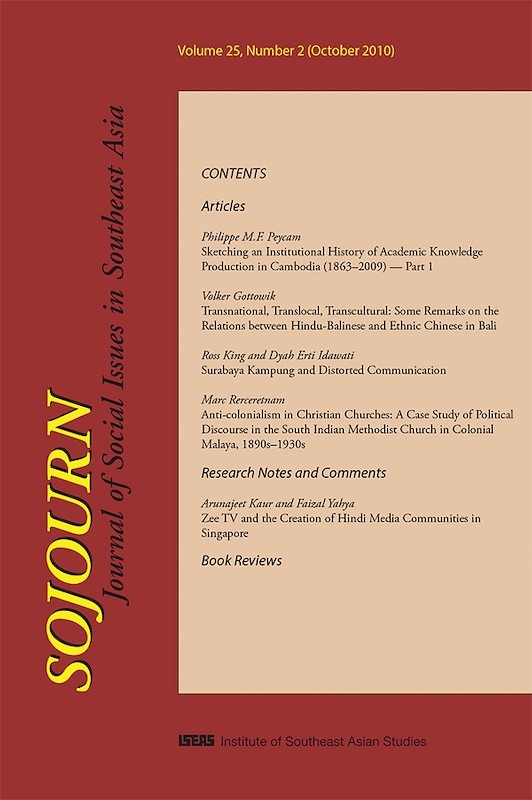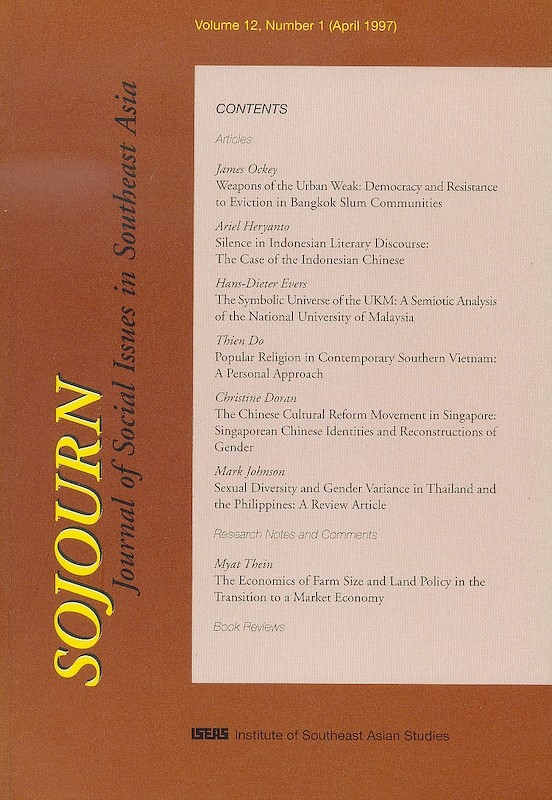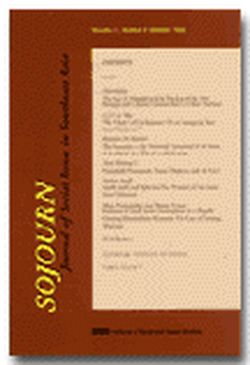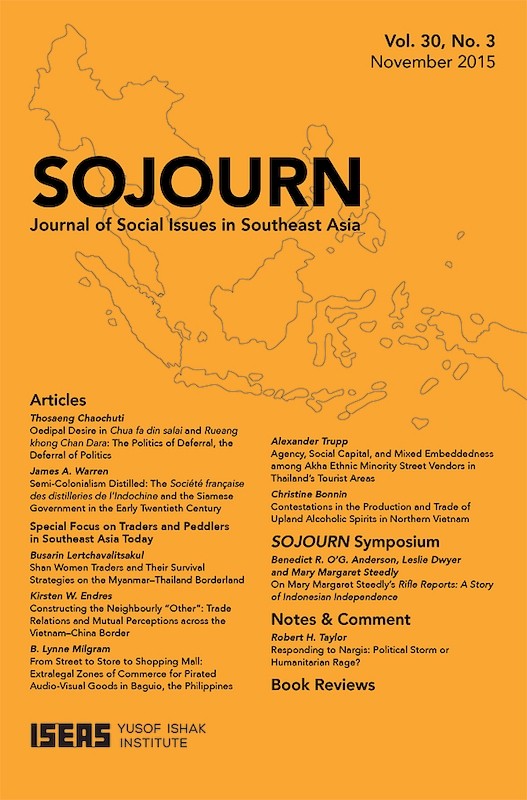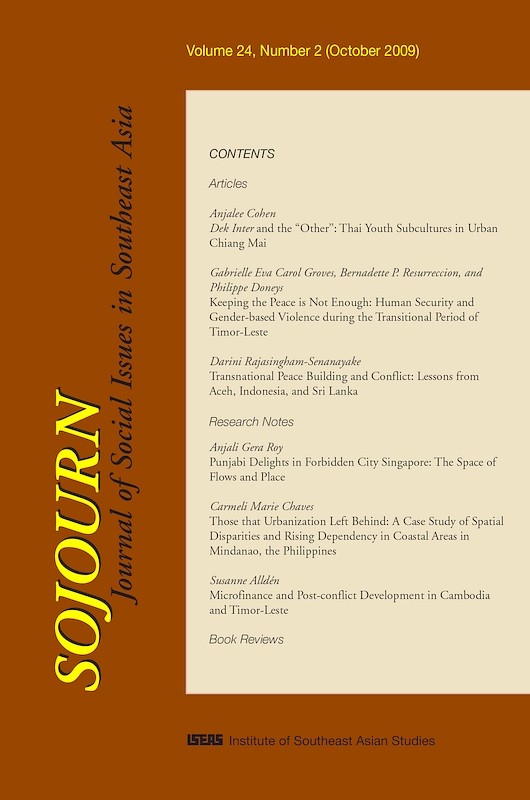SOJOURN: Journal of Social Issues in Southeast Asia Vol. 17/1 (Apr 2002)
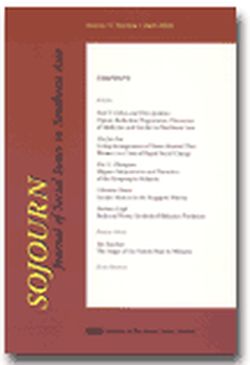
Date of publication:
May 2002
Publisher:
Institute of Southeast Asian Studies
Number of pages:
136
Code:
SJ17/1
Contents
-
SOJOURN: Journal of Social Issues in Southeast Asia Vol. 17/1 (Apr 2002)
-
Preliminary pages
-
Opium-Reduction Programmes, Discourses of Addiction and Gender in Northwest Laos, by Paul T Cohen, Chris Lyttleton, authors see abstractIn Muang Sing district of northwest Laos, a community-based detoxification programme was recently launched among the highland Akha. The Akha grow almost all the poppy in the district and have high rates of opium addiction. Whereas the attitude of the Akha to opium is generally one of ambivalence, the detoxification programme portrays opium in unambiguously negative terms, with the consequent inculcation of an addict identity and a strong sense of shame among relapsed addicts. On the other hand, the programme has more positive consequences for women. Even though historically fewer women than men become addicts, women often bear the brunt of the burden. The detoxification programme gives women a voice against addiction, but this empowerment remains circumscribed within a patriarchal society.
-
Living Arrangements of Never-Married Thai Women in a Time of Rapid Social Change, by Tan Joo Ean, author see abstractAs a result of rapid industrialization in Southeast Asia, the family stands in need of careful attention. This article examines the family in Thailand by focusing on changes in the living arrangements of never-married women aged 3034 and 4044 between the years 1970 and 1990. The living arrangements of these women have been rather stable in the wake of the economic transformation in Thailand. A high proportion of these women continue to live in households with relatives or households headed by relatives. This suggests that the norms that govern familial ties continue to be strong and resilient in Thailand.
-
Migrant Subjectivities and Narratives of the Kampung in Malaysia, by Eric C Thompson, author see abstractKampung figures prominently in a structure of feeling that contrasts rural and urban in Malaysia. While rural to urban migration and urbanization have proceeded apace in Malaysia, the kampung continues to play an important role in the lives of the country's Malay community and in Malaysia's national cultural geography. This article examines the place of the kampung in that cultural geography as it is related in the narratives of return migrants to the kampung of Sungai Siputeh in northern peninsular Malaysia. The article argues that return migrants are existentially engaged in fashioning their own lives in relationship to this discourse as they move between rural and urban spaces. Moreover, within rural Malaysia, their narratives shape the cultural geography of rural subjects.
-
Gender Matters in the Singapore Mutiny, by Christine Doran, author see abstractIn 1915 a rebellion broke out among the Fifth Light Infantry of the British Indian Army, which was stationed in Singapore. Several historical studies on the Singapore Mutiny are already available, but so far no analysis has been offered of the ways in which gender issues became entwined within British constructions of the significance of the rebellion. This article explores some gender matters arising from the Singapore Mutiny. It considers how the British colonizers created gendered interpretations of the uprising, with images of lecherous as well as treacherous Indian rebels targeting British womanhood. A comparison is suggested between the ways in which the British mythologized the Singapore Mutiny and their constructions of the significance of the Indian Mutiny of 1857.
-
Batik and Pewter: Symbols of Malaysian Pianissimo, by Julien Barbara, author see abstractNational symbols are part of a country's historical material culture. They are an indication of how those in power within the country wish the nation to be represented on the global stage. Intersecting with such cultural and political factors are the ways in which economic enterprises construct objects or artifacts that over time assume the status of national icons. The focus in this article is on two examples of Malaysian material culture that are accepted by visitors and promoted by the government as national symbols batik and pewter. The making of these national material cultural identities provides a window to broader sociological dynamics. These can be viewed as a manifestation of a process where the government negotiates a softly articulated balance between the interests and concerns of its political constituency and the rigorous demands of the market a Malaysian pianissimo.
-
The Magic of the Nation-State in Malaysia, by Yao Souchou, author
-
BOOK REVIEW: Women and Households in Indonesia: Cultural Notions and Social Practices. Edited by Juliette Koning, Marleen Nolten, Janet Rodenburg, and Ratna Saptari, by Maila Stivens, author
-
BOOK REVIEW: Lee Kuan Yew: The Beliefs Behind the Man. By Michael D. Barr, by Philip Holden, author
-
BOOK REVIEW: An Identity Dilemma: A Comparative Study of Primary Education for Ethnic Chinese in the Context of National Identity and Nation-Building in Malaysia and Singapore. By Ingrid Glad, by Ruth Hayhoe, author
-
BOOK REVIEW: Civility and Savagery: Social Identity in Tai States. Edited by Andrew Turton. Richmond, by Niti Pawakapan, author

